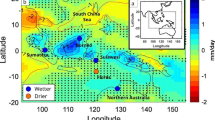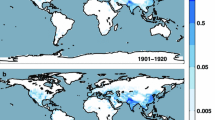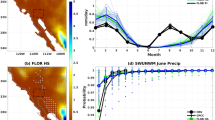Abstract
Agricultural intensification in South Asia has resulted in the expansion and intensification of surface irrigation over the twentieth century. The resulting changes to the surface energy balance could affect the temperature contrasts between the South Asian land surface and the equatorial Indian Ocean, potentially altering the South Asian Summer Monsoon (SASM) circulation. Prior studies have noted apparent declines in the monsoon intensity over the twentieth century and have focused on how altered surface energy balances impact the SASM rainfall distribution. Here, we use the coupled Goddard Institute for Space Studies ModelE-R general circulation model to investigate the impact of intensifying irrigation on the large-scale SASM circulation over the twentieth century, including how the effect of irrigation compares to the impact of increasing greenhouse gas (GHG) forcing. We force our simulations with time-varying, historical estimates of irrigation, both alone and with twentieth century GHGs and other forcings. In the irrigation only experiment, irrigation rates correlate strongly with lower and upper level temperature contrasts between the Indian sub-continent and the Indian Ocean (Pearson’s r = −0.66 and r = −0.46, respectively), important quantities that control the strength of the SASM circulation. When GHG forcing is included, these correlations strengthen: r = −0.72 and r = −0.47 for lower and upper level temperature contrasts, respectively. Under irrigated conditions, the mean SASM intensity in the model decreases only slightly and insignificantly. However, in the simulation with irrigation and GHG forcing, inter-annual variability of the SASM circulation decreases by ~40 %, consistent with trends in the reanalysis products. This suggests that the inclusion of irrigation may be necessary to accurately simulate the historical trends and variability of the SASM system over the last 50 years. These findings suggest that intensifying irrigation, in concert with increased GHG forcing, is capable of reducing the variability of the simulated SASM circulation and altering the regional moisture transport by limiting the surface warming and reducing land–sea temperature gradients.










Similar content being viewed by others
References
Alory G, Meyers G (2009) Warming of the Upper Equatorial Indian Ocean and changes in the heat budget (1960–99). J Clim 24:93–113
Ball JT, Woodrow IE, Berry JA (1987) A model predicting stomatal conductance and its application to the control of photosynthesis under different environmental conditions. In: Biggins I (ed) Progress in photosynthesis. Nijhoff, Zoetermeer, pp 221–224
Bonfils C, Lobell D (2007) Empirical evidence for a recent slowdown in irrigation-induced cooling. Proc Natl Acad Sci 104(34):13,582
Compo GP, Whitaker JS, Sardeshmukh PD, Matsui N, Allan RJ, Yin X, Gleason BE, Vose RS, Rutledge G, Bessemoulin P, Brönnimann S, Brunet M, Crouthamel RI, Grant AN, Groisman PY, Jones PD, Kruk M, Kruger AC, Marshall GJ, Maugeri M, Mok HY, Nordli O, Ross TF, Trigo RM, Wang XL, Woodruff SD, Worley SJ (2011) The twentieth century reanalysis project. Q J R Meteorol Soc 137:1–28
Cook BI, Puma MJ, Krakauer NY (2011) Irrigation induced surface cooling in the context of modern and increased greenhouse gas forcing. Clim Dyn 37:1587–1600
Cramer W (2006) Air pollution and climate change both reduce Indian rice harvests. Proc Natl Acad Sci 103(52):19609–19610
Douglas EM, Niyogi D, Frolking S, Yeluripati JB, Pielke RA Sr, Niyogi N, Vorosmarty CJ, Mohanty UC (2006) Changes in moisture and energy fluxes due to agricultural land use and irrigation in the Indian Monsoon Belt. Geophys Res Lett 33:L14403. doi:10.1029/2006GL026550
Douglas EM, Beltran-Przekurat A, Niyogi D, Pielke RA Sr, Vorosmarty CJ (2009) The impact of agricultural intensification and irrigation on land-atmosphere interactions and Indian monsoon precipitation—a mesoscale modeling perspective. Global Planet Change 67:117–128
Farquhar GD, von Caemmerer S, Berry JA (1980) A biochemical model of photosynthetic CO2 assimilation in leaves of C3 species. Planta 149:78–90
Federer CA, Vörösmarty C, Fekete B (2003) Sensitivity of annual evaporation to soil and root properties in two models of contrasting complexity. J Hydrometeorol 4(6):1276–1290
Freydank, K, Siebert S (2008) Towards mapping the extent of irrigation in the last century: time series of irrigated area per country. Tech. Rep. Frankfurt Hydrol. Pap. 08, Inst. of Phys. Geogr., Univ. of Frankfurt, Frankfurt, Germany
Guimberteau M, Laval K, Perrier A, Polcher J (2011) Global effect of irrigation and its impact on the onset of the Indian summer monsoon. Clim Dyn. doi:10.1007/s00382-011-1251-5
Hansen J, Sato M, Ruedy R, Kharecha P, Lacis A, Miller R, Nazarenko L, Lo K, Schmidt GA, Russell G, Aleinov I, Baue S, Baum E, Cairns B, Canuto V, Chandler M, Cheng Y, Cohen A, Del Genio A, Faluvegi G, Fleming E, Friend A, Hall T, Jackman C, Jonas J, Kelley M, Kiang NY, Koch D, Labow G, Lerner J, Menon S, Novakov T, Oinas V, Perlwitz J, Perlwitz J, Rind D, Romanou A, Schmunk R, Shindell D, Stone P, Sun S, Streets D, Tausnev N, Thresher D, Unger N, Yao M, Zhang S (2007) Climate simulations for 1880–2003 with GISS modelE. Clim Dyn 29:661–696. doi:10.1007/s00382-007-255-8
Hazel PBR (2009) The Asian Green Revolution. IFPRI Discussion Paper 00911
Jha S (2001) Rainwater Harvesting in India. Press Information Bureau, Government of India, New Delhi, India. http://pib.nic.in/feature/feyr2001/fsep2001/f060920011.html. Accessed 12 June 2006
Kalnay E, Kanamitsu M, Kistler R, Collins W, Deaven D, Gandin L, Iredell M, Saha S, White G, Woollen J, Zhu Y, Chelliah M, Ebisuzaki W, Higgins W, Janowiak J, Mo KC, Ropelewski C, Wang J, Leetmaa A, Reynolds R, Jenne R, Joseph D (1996) The NCEP/NCAR 40-year reanalysis project. Bull American Met Soc 77(3):437–471
Krishna Kumar K, Rupa Kumar K, Ashrit RG, Deshpande NR, Hansen JW (2004) Climate impacts on Indian agriculture. Int J Climatol 24:1375–1393
Kueppers L, Snyder M, Sloan L (2007) Irrigation cooling effect: regional climate forcing by land-use change. Geophys Res Lett 34(3):L03,703
Lal M (2011) Implications of climate change in sustained agricultural productivity in South Asia. Reg Environ Change Suppl 1:S79–S94
Lau KM, Kim MK, Kim KM (2006) Asian summer monsoon anomalies induced by aerosol direct forcing: the role of the Tibetan Plateau. Clim Dyn 26:855–864
Lee E, Chase TN, Rajagopalan B, Barry RG, Biggs TW, Lawrence PJ (2008) Effects of irrigation and vegetation activity on early Indian summer monsoon variability. Intl J Climatol. doi:10.1002/joc.1721
Lobell D, Bonfils C, Faures J (2008) The role of irrigation expansion in past and future temperature trends. Earth Interact 12(3):1–11
Mall RK, Gupta A, Singh R, Sing RS, Rathore LS (2006a) Water resources and climate change: an Indian perspective. Curr Sci 90:1610–1626
Mall RK, Singh R, Gupta A, Srinivasan G, Rathore LS (2006b) Impact of climate change on Indian agriculture: a review. Clim Change 78:445–478
Matthews E (1983) Global vegetation and land use: new high-resolution data bases for climate studies. J Appl Meteorol 22(3):474–487
Matthews E (1984) Prescription of land surface boundary conditions in GISS GCM II: a simple method based on fine resolution data bases, NASA Tech Memo, 86096, p 20
Niyogi D, Kishtawal C, Tripathi S, Govindaraju RS (2010) Observational evidence that agricultural intensification and land use change may be reducing the Indian summer monsoon rainfall. Water Resour Res 46:W03533. doi:10/1029/2008WR007082
Parthasarathy B, Munot AA, Kothawale DR (1995) All India monthly and seasonal rainfall series: 1871–1993. Theor Appl Climatol 49:217–224
Puma MK, Cook BI (2010) Effects of irrigation on global climate during the 20th century. J Geophys Res 115:D16,120
Ramanathan V, Agrawal M, Akimoto H, Auffhammer M, Devotta S, Emberson L, Hasnain SI, Iyngararasan M, Jayaraman A, Lawrence M, Nakajima T, Oki T, Rodhe H, Ruchirawat M, Tan SK, Vincent J, Wang JY, Yang D, Zhang YH, Autrup H, Barregard L, Bonasoni P, Brauer M, Brunekreef B, Carmichael G, Chung CE, Dahe J, Feng Y, Fuzzi S, Gordon T, Gosain AK, Htun N, Kim J, Mourato S, Naeher L, Navasumrit P, Ostro B, Panwar T, Rahman MR, Ramana MV, Rupakheti M, Settachan D, Singh AK, St. Helen G, Tan PV, Viet PH, Yinlong J, Yoon SC, Chang WC, Wang X, Zelikoff J, Zhu A (2008) Atmospheric Brown Clouds: Regional Assessment Report with Focus on Asia, published by the United Nations Environment Program, Nairobi, Kenya, pp 1–360
Saeed F, Hagemann S, Jacob D (2009) Impact of irrigation on the South Asian summer monsoon. Geophys Res Lett 36:L20711. doi:10.1029/2009GL040625
Schmidt GA, Ruedy R, Hansen JE, Aleinov I, Bell N et al (2006) Present-day atmospheric simulations using GISS ModelE: comparison to in situ, satellite and reanalysis data. J Clim 19:153–191
Sen Roy S, Mahmood R, Niyogi D, Lei M, Foster SA, Hubbard KG, Douglas E, Pielke Sr. R (2007) Impacts of the agricultural Green Revolution-induced land use changes on air temperatures in India. J Geophys Res 112:D21,108
Sen Roy S, Mahmood R, Quintanar AI, Gonzalez A (2010) Impacts of irrigation on dry season precipitation in India. Theor Appl Climatol. doi:10/1007/s00704-010-0338-z
Shukla S (2011) The Impact of a Warmer Climate on Atmospheric Circulation with Implications for the Asian Summer Monsoon. Doctoral Dissertation, Columbia University
Siebert S, Döll P, Feick S, and Hoogeveen J (2005a) Global map of irrigated areas version 2.2. Tech. Rep., Johann Wolfgang Goethe Univ., Frankfurt, Germany
Siebert S, Döll P, Hoogeveen J, Faures JM, Frenken K, Feick S (2005b) Development and validation of the global map of irrigation areas. Hydrol Earth Syst Sci 9(5):353–547
Sun Y, Ding Y, Dai A (2010) Changing links between Summer Asian summer monsoon circulation and tropospheric land–sea thermal contrasts under a warming scenario. Geophys Res Lett 37:L02,704
Wang B (2006) The Asian monsoon. Springer, Chichester
Webster PJ, Yang S (1992) Monsoon and ENSO: selectively interactive systems. Q J R Meteorol Soc 118:877–926
Wisser D, Fekete BM, Vorosmarty CJ, Schumann AH (2010) Reconstructing 20th century global hydrography: a contribution to the global terrestrial network-hydrology (GTN-H). Hydrol Earth Syst Sci 14:1–24
Yanai M, Wu GX (2006) Effects of the Tibetan Plateau. In: Wang B (ed) The Asian monsoon. Sringer, Chichester, pp 513–549
Acknowledgments
This research was supported by an appointment to the NASA Postdoctoral Program at the Goddard Institute for Space Studies, administered by Oak Ridge Associated Universities through a contract with NASA. M. J. Puma gratefully acknowledges funding for Interdisciplinary Global Change Research under NASA cooperative agreement NNX08AJ75A supported by the NASA Climate and Earth Observing Program. The authors thank two anonymous reviewers whose comments greatly improved the quality of this manuscript. Resources supporting this work were provided by the NASA High-End Computing (HEC) Program through [the NASA Advanced Supercomputing (NAS) Division at Ames Research Center and] the NASA Center for Climate Simulation (NCCS) at Goddard Space Flight Center.
Author information
Authors and Affiliations
Corresponding author
Rights and permissions
About this article
Cite this article
Shukla, S.P., Puma, M.J. & Cook, B.I. The response of the South Asian Summer Monsoon circulation to intensified irrigation in global climate model simulations. Clim Dyn 42, 21–36 (2014). https://doi.org/10.1007/s00382-013-1786-9
Received:
Accepted:
Published:
Issue Date:
DOI: https://doi.org/10.1007/s00382-013-1786-9




